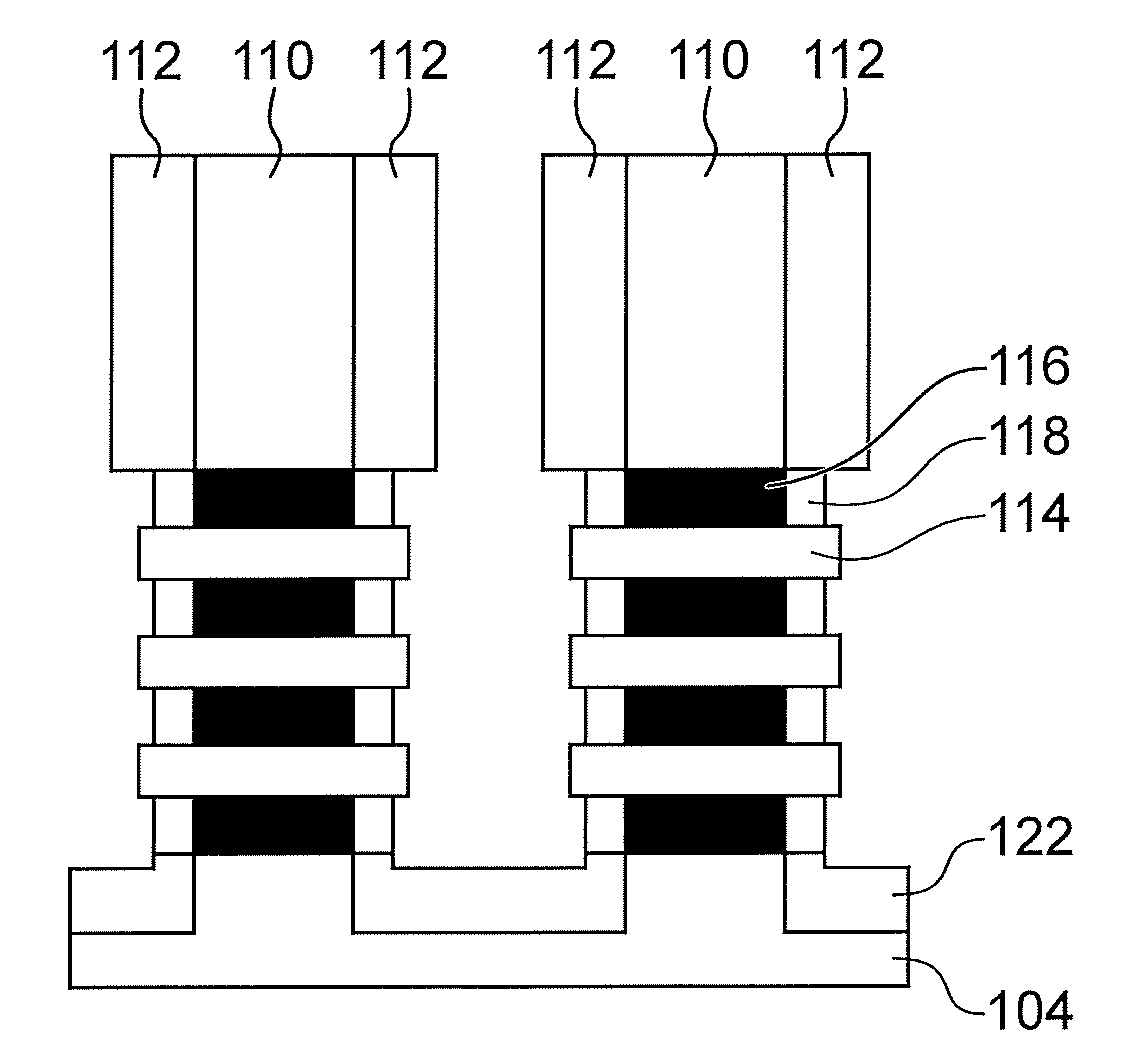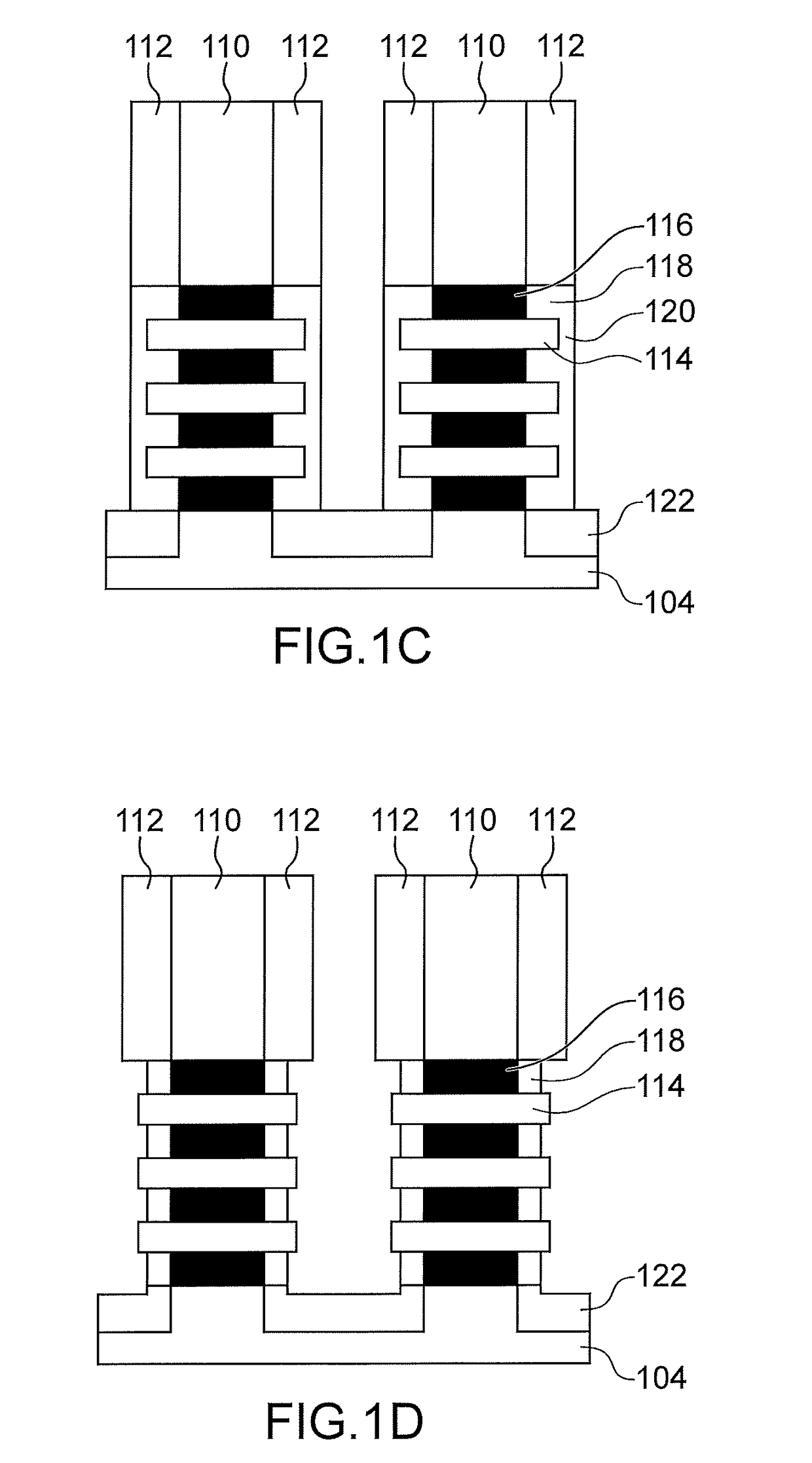Method for making a semiconductor device with self-aligned inner spacers
a technology of inner spacers and semiconductors, applied in the field of making a semiconductor device, can solve the problems of difficult alignment between the inner edges of the outer spacers and the side the difficulty of aligning between the channel region and the walls of the cavities,
- Summary
- Abstract
- Description
- Claims
- Application Information
AI Technical Summary
Benefits of technology
Problems solved by technology
Method used
Image
Examples
first embodiment
[0059]FIGS. 1A to 1G are first referred to which show the steps of a method for making a semiconductor device 100 including herein two P-type GAA-FET transistors, according to a
[0060]As shown in FIG. 1A, the device 100 is made from a stack 102 of layers of different materials which is arranged on a substrate 104. In the first embodiment described here, the substrate 104 corresponds to a “bulk” semiconductor substrate, for example of silicon or SiGe. The stack 102 comprises layers 106, 108 of two different materials and alternately arranged above each other. Each of the layers 108 is intended to form one or more semiconductor nanowires of one or more channels of the device 100 and is arranged between two layers 106 including a material able to be selectively etched relative to that of the layers 108. In the first embodiment described herein, the stack 102 includes three layers 108 as well as four layers 106 alternately arranged such that each of the layers 108 is arranged between two...
second embodiment
[0096]A method for making the device 100 is described in connection with FIGS. 2A to 2D.
[0097]The initial stack 102 used in this second embodiment is similar to that used in the first embodiment.
[0098]The steps previously described in connection with FIGS. 1A and 1B are first implemented. However, unlike the first embodiment in which the nanowires 114 are broken between two transistors, the etching of the stack 102 which is implemented is such that the nanowires 114 of the two transistors are here formed by continuous portions which are not broken at the future common source and drain region intended to be made for both these transistors. The structure obtained is shown in FIG. 2A.
[0099]As for the first embodiment previously described, a partial oxidation of the portions 116, from the surfaces forming the side flanks of the structures obtained by implementing the previous etching, is then implemented, forming the inner spacers 118.
[0100]Further, a part of the nanowires 114 is oxidi...
third embodiment
[0112]A method for making the device 100 is described in connection with FIGS. 3A to 3I. In these Figs., making a single GAA-FET transistor is described.
[0113]The initial stack 102 used in this third embodiment is similar to that used in the first and second embodiments.
[0114]As in the first and second embodiments previously described, the stack 102 is first etched as one or more elongate portions (a single elongate portion being shown in FIG. 3A), and then a dummy gate 110 and temporary outer spacers 301 are then made on the elongate portion formed from the stack 102, without a subsequent etching of the parts of the stack 102 which are not covered with the temporary outer spacers 301.
[0115]A packaging material 303 is then deposited onto the parts of the layers 106, 108 at which the future source and drain regions of the transistor will be made (FIG. 3A).
[0116]As shown in FIG. 3B, the temporary outer spacers 301 as well as the parts of the layers 106, 108 which are covered with the...
PUM
 Login to View More
Login to View More Abstract
Description
Claims
Application Information
 Login to View More
Login to View More - R&D
- Intellectual Property
- Life Sciences
- Materials
- Tech Scout
- Unparalleled Data Quality
- Higher Quality Content
- 60% Fewer Hallucinations
Browse by: Latest US Patents, China's latest patents, Technical Efficacy Thesaurus, Application Domain, Technology Topic, Popular Technical Reports.
© 2025 PatSnap. All rights reserved.Legal|Privacy policy|Modern Slavery Act Transparency Statement|Sitemap|About US| Contact US: help@patsnap.com



